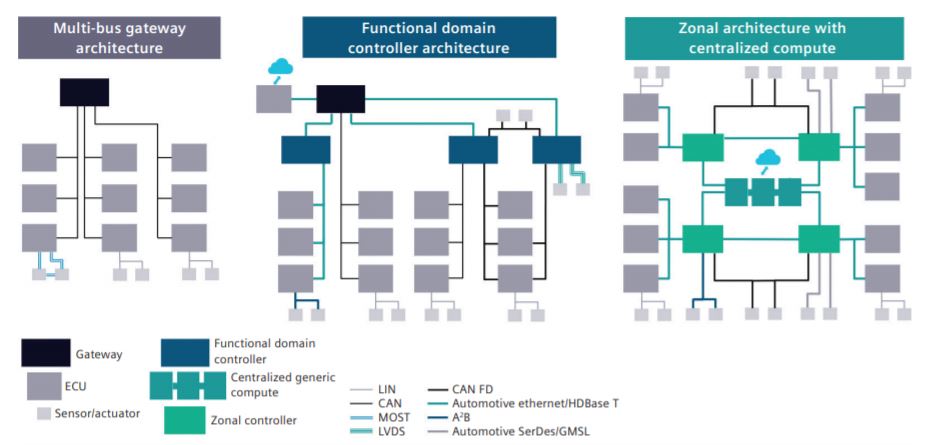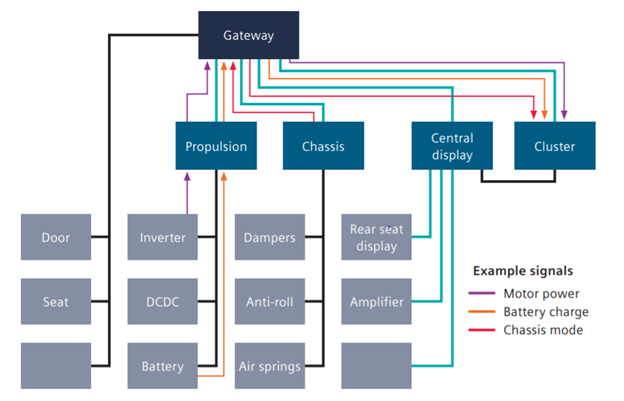Manage today’s advanced vehicle networks E/E design challenges
Several challenges and considerations go into developing the electrical and electronic (E/E) architectures in today’s sophisticated and highly connected on- and off-highway vehicles. The interdependent design objectives, the technologies that can be used to reduce the risk and time the taken in resolving these complexities all need to be taken into account and managed.
With today’s highly complex E/E architectures, the functionality of many vehicle features is distributed across multiple discrete ECUs. The ECUs, sensors and actuators are not all directly connected, and much of the data communication occurs across networks, often through gateways over several networks. Modern E/E architectures are formally organized around functional domains, increasingly with domain computers or controllers acting as a centralized compute resource, absorbing much of the higher-level functions for that domain.
Increasing use of service-oriented architectures (SOA) enabled by Ethernet networking allow principles from the information technology (IT) domain to be re-used in automotive applications. The main evolution in SOA is the move from thinking about discrete signals to services, which provide multiple related signals. Subscriptions to these are based on what is appropriate to the functional needs.
SOA occurs in parallel with changes to the physical architecture. Computing power is increasingly centralized, with domain ECUs reorganized into a zonal layout. Some OEMs and integrators opt for high computing power in the zonal ECUs that reside near the sensors and actuators, while others prefer relatively simple gateways. Also, moving away from functional domains cascades high integrity requirements into more ECUs across the architecture. These architectures can streamline the scalability of functionality, with processing and memory headroom provisioned only in the central compute unit. Centralized or zonal architectures also help reduce the mass of the harness and lower the bill-of-material (BoM) costs to the OEM. The speed of this transition is variable across organizations, regions and vehicle market sectors (Figure 1).
Increasingly, the instrument cluster, central display(s) and heads-up display (HUD) are part of one integrated system that is an extension of the driver information and infotainment systems. With more information in the instrument cluster having functional safety considerations, several partitions are still required on the compute platforms hosting these functions; such partitions may be separate processors or merely separate cores. These systems may have discrete LEDs, switches and other peripherals connected to fully meet their requirements. However, traditional automotive vehicle control switchgear is often connected to a body controller or gateway.
Besides the media functions hosted in the infotainment portion of this system, other pieces of critical driver information range from vehicle speed and faults through driving modes, ice warnings, navigation directions, estimated range and more. Some OEMs call the cluster a ‘combination meter’. This cluster brings together what were once multiple instrumentation gauges, warning lights, and trip computer elements in one system. Every time functions are consolidated, new functions are added in new components or ECUs, from trip computers through to clocks, temperature gauges and ice warnings (Figure 2).
For the automotive network designer, each design decision has an impact on the full system and should be considered at the time of design, allowing system testing later in the process to confirm correct behavior rather than uncover issues requiring design iterations.
There are several critical areas for vehicle networks design, and a robust solution is needed to manage the challenges to achieve key vehicle design requirements. These include:
- Network load and gateway load
- Ethernet and switches
- Functional Safety
- Cyber Security
- Power Modes
- Design Complexity
These challenges and decisions can have widespread, cross-domain effects that are difficult to predict or fully understand. Connecting the many disciplines enables designers to understand the downstream impacts of their decisions during development. This is critical to accelerating the vehicle development process. Networks design considers and implements many elements vital to ensuring correct vehicle functionality and protecting the entire system from incorrect sub-system behavior. Selecting a solution which consistently and correctly generates the configurations and documentation used in bringing the development and validation of each ECU comprising the full system is crucial.
Capital Networks from Siemens addresses the specific needs of vehicle networks design reliability. Used by multiple OEMs across the world, including within the AUTOSAR flow and framework, Capital Networks is one of the automotive industry’s most robust software tools. A model-based design solution, it offers generative design capabilities to ensure efficient design of performant networks across the multiple interdependent complexities of modern E/E architectures across multiple vehicle platforms.
Download the white paper, Real-World Considerations for Advanced Vehicle Networks Design to learn more.
 Brendan Morris is a senior technical marketing manager for the Integrated Electrical Systems group, Siemens Digital Industries Software. He spent his early career at Automotive Tier 1 suppliers and the next 10 years working for vehicle OEMs at all stages of vehicle development. Brendan holds an M.Eng degree in Automotive Engineering from Loughborough University.
Brendan Morris is a senior technical marketing manager for the Integrated Electrical Systems group, Siemens Digital Industries Software. He spent his early career at Automotive Tier 1 suppliers and the next 10 years working for vehicle OEMs at all stages of vehicle development. Brendan holds an M.Eng degree in Automotive Engineering from Loughborough University. 



